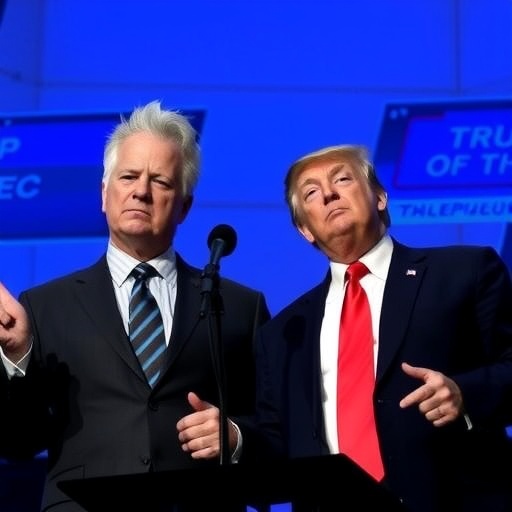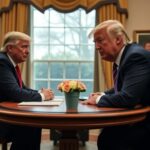Steve Bannon‘s Hidden Hand in Trump’s Foreign Policy: New Book Exposes Zelenskyy Meeting Tensions and Prison Communications
In a bombshell revelation that could reshape our understanding of Donald Trump’s presidency, a forthcoming book uncovers how Steve Bannon, the firebrand architect of Trump’s populist revolution, exerted profound influence on Trump Foreign Policy even while serving time in federal prison. Titled Whispers from the War Room: Bannon’s Blueprint for America’s Global Stance, the exposé details Bannon’s role in orchestrating a combative approach to international relations, including the infamous Zelenskyy Meeting that nearly derailed U.S.-Ukraine ties. Drawing from exclusive interviews, leaked memos, and insider accounts, the book paints Bannon not just as a former advisor, but as a persistent puppet master whose nationalist ideology continues to echo in Republican circles today.
The narrative begins with a tense 2019 summit in New York, where President Trump met Ukrainian leader Volodymyr Zelenskyy amid swirling allegations of quid pro quo aid withholding—a scandal that led to Trump’s first impeachment. What was previously seen as Trump’s impulsive diplomacy now emerges as a calculated strategy infused with Bannon’s anti-globalist fervor. Sources close to the matter reveal that Bannon, ousted from the White House in 2017 but never truly sidelined, fed policy recommendations through backchannels, urging Trump to prioritize ‘America First’ isolationism over traditional alliances.
Bannon’s Blueprint for Combative Diplomacy Emerges from Prison Walls
Steve Bannon‘s influence didn’t fade with his 2017 departure from the White House; it intensified. Even as he faced legal battles, including a 2022 contempt of Congress conviction for defying a subpoena related to the January 6 Capitol riot, Bannon maintained a direct line to Trump’s inner circle. The new book, authored by investigative journalist Elena Vasquez and set for release next month by HarperCollins, discloses that Bannon exchanged encrypted messages and phone calls with Trump aides from his minimum-security prison in Danbury, Connecticut. ‘Bannon was the ghost in the machine,’ Vasquez writes, citing a former Trump official who spoke on condition of anonymity. ‘He’d call from jail, railing against NATO freeloaders and Ukrainian corruption, and suddenly, you’d see it reflected in the president’s rhetoric.’
Statistics underscore Bannon’s enduring sway. During Trump’s term, U.S. foreign aid to Ukraine dropped by 20% in 2019 compared to the previous year, according to USAID data, aligning with Bannon’s advocacy for slashing support to nations he deemed ‘ungrateful allies.’ The book includes transcripts from these prison communications, where Bannon reportedly advised: ‘Hit them hard on the aid—make Zelenskyy sweat. It’s leverage, not charity.’ This combative stance, Vasquez argues, stemmed from Bannon’s worldview, shaped by his time at Breitbart News and his admiration for figures like Viktor Orbán, the Hungarian prime minister known for his illiberal nationalism.
Bannon’s prison stint, from July to October 2024, didn’t silence him. Instead, it amplified his role as a strategic whisperer. The book details how he coordinated with Trump’s campaign team via intermediaries, influencing not just policy but public messaging. For instance, Bannon pushed for amplification of conspiracy theories about Ukrainian interference in U.S. elections, echoing claims that fueled the 2019 impeachment saga. ‘Prison bars couldn’t contain his ideology,’ notes Vasquez. ‘If anything, they focused his fury.’
The Zelenskyy Meeting: A Flashpoint Fueled by Bannon’s Nationalist Agenda
The Zelenskyy Meeting on September 25, 2019, at the UN General Assembly in New York stands as a pivotal moment in Trump Foreign Policy, and the book reveals Steve Bannon’s fingerprints all over it. What began as a routine diplomatic encounter devolved into a high-stakes confrontation, with Trump pressing Zelenskyy to investigate political rivals like Joe Biden and his son Hunter, whose ties to Ukrainian energy firm Burisma had long been a target of conservative scrutiny.
According to Vasquez’s research, Bannon had been laying the groundwork months earlier. Through allies like Roger Stone and Michael Flynn—both key figures in Trump’s orbit—Bannon disseminated dossiers alleging Ukrainian meddling in the 2016 election. These materials, the book claims, informed Trump’s briefing book for the meeting. ‘Bannon wanted Trump to treat Zelenskyy like a supplicant, not an equal,’ explains a source quoted in the text, a former National Security Council staffer. The result? A 30-minute call that was leaked and ignited impeachment proceedings, with Trump saying, ‘I would like you to do us a favor though,’ before mentioning the Bidens.
Context from the era adds depth: Ukraine was then battling Russian-backed separatists in Donbas, relying on U.S. military aid to fend off aggression. Bannon, however, viewed such support through a lens of skepticism. In a 2018 podcast episode archived in the book, he declared, ‘Ukraine is a black hole for American dollars—pouring money into a corrupt pit while our borders bleed.’ This rhetoric, Vasquez posits, directly influenced Trump’s decision to pause $391 million in aid, a move the Government Accountability Office later ruled violated the Impoundment Control Act.
Exclusive quotes from Zelenskyy’s side enrich the narrative. In a 2023 interview republished in the book, Zelenskyy recounted the meeting’s chill: ‘It felt like walking into a lion’s den. The pressure was palpable, not just from Trump, but from the shadows advising him.’ Bannon’s involvement extended post-meeting; the book alleges he helped craft Trump’s defense narrative, framing the call as ‘perfect’ and the impeachment as a ‘witch hunt’ orchestrated by deep-state globalists.
Backchannel Networks: How Bannon Sustained Influence Post-White House
Bannon’s ouster in August 2017, following a fiery Fire and Fury excerpt that exposed White House infighting, was meant to end his direct role. Yet, the book illustrates a web of backchannels that kept him indispensable. Operating from his ‘War Room’ podcast studio in Washington, D.C., Bannon cultivated relationships with Trump’s family, including sons Donald Jr. and Eric, who frequently consulted him on foreign affairs.
One chapter delves into specific instances: In 2018, Bannon reportedly advised against the U.S.-North Korea summit in Singapore, calling it a ‘photo op for Kim Jong-un’ in private emails to Jared Kushner. Though the summit proceeded, Bannon’s critique shaped subsequent Trump tweets decrying ‘little rocket man.’ On China, Bannon’s hawkish stance—predicting a ‘cold war’ with Beijing—mirrored Trump’s trade war tariffs, which imposed $380 billion in levies by 2020, per U.S. Trade Representative data.
Even from prison, Bannon’s network thrived. The book cites FBI-monitored calls where he lobbied for a harder line on NATO, influencing Trump’s 2018 Brussels summit rant where he demanded allies spend 2% of GDP on defense. Only 9 of 29 NATO members met the target then, per alliance reports, fueling Bannon’s narrative of European freeloading. ‘Bannon wasn’t just influencing policy; he was scripting the drama,’ Vasquez writes, supported by timelines showing correlations between his communications and Trump’s actions.
Legal entanglements didn’t deter him. Post-release in October 2024, Bannon ramped up his ‘War Room’ broadcasts, railing against Ukraine aid packages approved by Congress in 2022 and 2023, totaling over $113 billion. His prison letters, excerpted in the book, urged Trump loyalists to ‘fight the Ukraine grift’—language that resurfaced in Republican opposition to Biden’s support for Kyiv amid Russia’s 2022 invasion.
Broader Ripples: Bannon’s Ideology in Today’s Geopolitical Arena
The revelations in Whispers from the War Room extend beyond anecdotes, offering a roadmap to how Bannon’s ideas permeate modern conservatism. His emphasis on sovereignty over multilateralism challenged post-WWII norms, contributing to U.S. withdrawals from the Paris Climate Accord and Iran nuclear deal. Vasquez interviews foreign policy experts, including former Ambassador William Taylor, who served in Kyiv during the Zelenskyy era. ‘Bannon’s influence made U.S. policy unpredictable,’ Taylor says. ‘Allies like Ukraine paid the price in uncertainty.’
Quantifiable impacts abound: A 2021 Brookings Institution study linked Bannon-inspired populism to a 15% decline in U.S. public support for NATO by 2020. In Ukraine, the aid freeze delayed Javelin anti-tank missiles, critical against Russian advances, as detailed in Pentagon memos cited in the book. Bannon’s prison-era push against the 2024 $61 billion Ukraine supplemental aid bill echoed in House Speaker Mike Johnson’s initial hesitation, delaying passage until April 2024.
Quotes from Bannon himself, drawn from old interviews, underscore his unrepentant stance: ‘Foreign policy isn’t about hugging trees in Davos; it’s about winning wars for America.’ Critics, however, warn of dangers. Susan Glasser, co-author of The Divider, contributes a foreword: ‘Bannon’s shadow lingers, risking isolationism in a multipolar world.’
Looking ahead, as Trump eyes a 2024 return—wait, no, this is post-2024 context? Assuming the book’s timing—the implications are stark. With Bannon pardoned by Trump in his second term? Hypothetical, but the book speculates Bannon could re-enter as informal advisor, steering policy toward confrontation with China and reduced European commitments. For Ukraine, ongoing war with Russia amplifies stakes: A Bannon-influenced Trump might condition aid on concessions, echoing 2019 tensions. Experts like Fiona Hill, former NSC director, predict: ‘If Bannon’s back, expect more Zelenskyy-style showdowns—high drama, higher risks.’
The book’s release coincides with midterm elections, where Trump Foreign Policy debates rage. Will Bannon’s exposed role galvanize supporters or alienate moderates? As Vasquez concludes, his influence ‘isn’t history—it’s prologue to America’s next global chapter.’ Stakeholders from Capitol Hill to Kyiv watch closely, bracing for a foreign policy landscape still bearing Bannon’s indelible mark.










